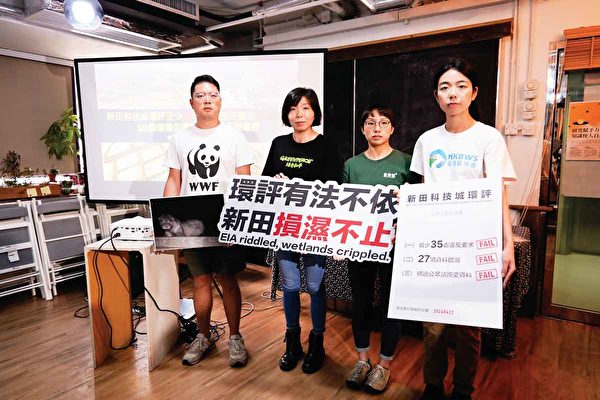The Environmental Consultation Committee (ECC) will discuss the Environmental Impact Assessment (EIA) report on the “San Tin / Lok Ma Chau Development Hub” next Monday (22nd). Ten environmental groups have found multiple issues with the EIA, including at least 35 instances of non-compliance with legal requirements, as well as a minimum of 27 technical assessment errors and data omissions. They also pointed out that the Civil Engineering and Development Department only disclosed controversial information after the conclusion of public consultation, raising suspicions of bypassing public oversight. The environmental groups described this wetland project’s legal EIA as “the worst in history,” urging committee members to fulfill their duties by rejecting the EIA and not ruling out the possibility of judicial review.
These ten environmental groups include the World Wide Fund for Nature Hong Kong, The Conservancy Association, Greenpeace, the Hong Kong Bird Watching Society, and the Guangzhou Zhuwan People and Ecological Environment Research Center. At a press conference yesterday, they bluntly stated that the San Tin Technology City is the largest wetland destruction project in 30 years, affecting nearly 247 hectares of wetland conservation areas and buffer zone land.
They criticized the sudden “illegal construction” of the development scale of the San Tin Technology City during the EIA process, the addition of land filling in 90 hectares of ponds, and the authorities’ refusal to comply with legal EIA requirements, worrying about significantly underestimating the impact of development on wetland and pond ecosystem.
The environmental groups also pointed out numerous errors in the government’s EIA, including a minimum of 27 serious technical assessment errors and data omissions, such as significant underestimation of habitat loss and fragmentation, and the impact on the Eurasian otter, a globally near-threatened species of national secondary key protected wildlife; inadequate scientific evidence to support the effectiveness of ecological compensation measures; and failure to propose mitigation and compensation measures for habitat loss during pond filling and construction periods.
The environmental groups further stated that in the past, during public consultations on EIAs, detailed wetland management plans and actual habitat construction schedules would be openly disclosed, but on the eve of EIA approval this time, the government has yet to fully disclose the “habitat management plan.”
They argue that the government’s EIA is riddled with major errors, and the overall standards fall short compared to submissions by private developers. Once the EIA is approved, there may be a risk of judicial review.
The environmental groups emphasized that the pond filling project of the San Tin Technology City will cause irreversible damage to ponds and wetlands. They believe that the government’s forceful push of the flawed EIA for the San Tin Technology City at the ECC meeting may lead the public to doubt the credibility of the EIA system and may set a detrimental precedent.
The environmental groups urge the ECC to carefully review and discuss the aforementioned errors one by one, and to avoid hastily approving the EIA without a professional report for full societal discussion, to prevent unprecedented severe damage to this unique wetland in the Greater Bay Area and to set a bad example, which may affect future wetland-related development projects in the northern metropolitan area.
When asked if they would seek judicial review, Miss Wong, Senior Conservation Officer of the Hong Kong Bird Watching Society, stated that since the entire EIA process is still incomplete, any possibility of judicial review would depend on the outcome.
According to records, the Kadoorie Farm and Botanic Garden announced in July last year the discovery of adult and young Eurasian otters in the Hau Hoi Wan wetland, believing it to be one of the most important habitats for otters in southern China. The park is concerned about the San Tin Technology City project, which could permanently remove approximately 90 hectares of ponds, reducing otter habitats and causing fragmentation. They hope that relevant parties will reconsider this plan and prioritize Eurasian otters as a conservation focus for future wetland conservation parks in the northern metropolitan area.

